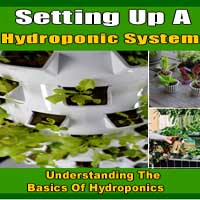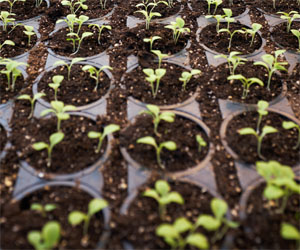


Nature's Blueprint For Healthy Gardens

Crop rotation is a time-honored agricultural practice that has been employed for centuries to maintain the health and productivity of gardens and fields. It involves a systematic change in the types of crops grown in specific areas from season to season. This strategic approach to farming provides numerous benefits, including improved soil quality, reduced pest and disease pressure, and increased crop yields. In this article, we will explore the importance of crop rotation and how it can be applied in your own garden.
The Basics Of Crop Rotation
Crop rotation is a technique that involves growing different types of crops in a specific sequence over multiple growing seasons. The primary objective is to prevent the continuous cultivation of the same crop in the same area, as this can deplete the soil of specific nutrients and increase the likelihood of soil-borne diseases and pests.
Key Benefits Of Crop Rotation
Soil Health: Crop rotation helps to maintain soil fertility and structure by preventing the excessive depletion of specific nutrients. Different crops have different nutrient requirements, so alternating them allows the soil to recover and regenerate.
Pest And Disease Management: Crop rotation disrupts the life cycles of many pests and diseases. By moving crops to different areas each season, you can reduce the build-up of pathogens and pests that are specific to certain plants.
Improved Yields: Healthier soil and reduced pest and disease pressure typically result in higher crop yields. By practicing crop rotation, you can expect better harvests over time.
Weed Control: Some crops can help suppress the growth of specific weeds. By rotating crops strategically, you can naturally reduce weed infestations.
Reduced Soil Erosion: Rotated crops with varying root structures can help improve soil stability, reducing the risk of erosion, especially in sloped areas.
Crop Rotation Strategies
Crop rotation strategies can vary, but a typical system often involves dividing crops into different categories and rotating them following a predetermined sequence. Here's a simple three-category rotation plan:
Legumes: This category includes plants like peas and beans that fix nitrogen in the soil. They can be the first crop in the rotation to enrich the soil with this essential nutrient.
Root Crops: Crops like carrots, potatoes, and beets make up the second category. They do not heavily deplete soil nitrogen levels and can benefit from the nitrogen fixed by the legumes.
Brassicas: The third category consists of crops like cabbage, broccoli, and kale. They require higher levels of soil nutrients and benefit from the previous categories' contributions.
After one season, the entire cycle repeats, and each category moves to the next field. In the following season, you can adapt the plan to fit the specific crops you wish to grow and account for any particular soil requirements.
Tips For Successful Crop Rotation
Plan Ahead: Create a rotation schedule to determine which crops to grow and where to plant them in each season. Consider the space you have and your garden's specific needs.
Maintain Good Records: Keep records of past plantings and crop performance. This information will help you make informed decisions for future rotations.
Soil Testing: Regular soil testing can help you assess the nutrient levels in your soil, allowing you to tailor your crop rotation to address specific deficiencies.
Companion Planting: Consider incorporating companion planting techniques within each rotation to further enhance plant health and discourage pests.
Crop rotation is a valuable practice that promotes soil health, pest and disease management, and higher crop yields. By thoughtfully planning and implementing a crop rotation system, you can contribute to the long-term sustainability and productivity of your garden. This age-old technique is a testament to the wisdom of nature and serves as a blueprint for maintaining healthy, thriving gardens year after year.




A Sustainable Future
 Defining Environmentally Friendly Homes
Defining Environmentally Friendly Homes
Environmentally friendly homes, often referred to as eco-friendly or green homes, are constructed and operated with a focus on reducing their impact on the environment. These homes adopt a holistic approach to sustainability, addressing various aspects of the building's design, construction, and operation. The goal is to minimize resource consumption, reduce energy usage, and limit greenhouse gas emissions.
Key Features Of Environmentally Friendly Homes
Energy Efficiency: Environmentally friendly homes prioritize energy efficiency through measures like well-insulated walls, roofs, and windows. They often incorporate high-efficiency heating and cooling systems and utilize energy-efficient lighting and appliances to reduce energy consumption.
Renewable Energy Sources: Many eco-friendly homes feature renewable energy sources such as solar panels, wind turbines, or geothermal heating and cooling systems. These technologies allow homeowners to generate their own clean energy and even feed excess energy back into the grid.
Water Efficiency: Water conservation is a critical component of environmentally friendly homes. Features like low-flow faucets, water-efficient appliances, and rainwater harvesting systems help reduce water consumption and lower utility bills.
The Future Of Comfort And Efficiency
 Automation And Control
Automation And Control
A central component of smart living spaces is automation and control. Homeowners can remotely manage and monitor their living spaces using smartphones, tablets, or voice-activated virtual assistants like Amazon's Alexa or Google Assistant. This level of control allows for real-time adjustments and customization, enhancing the overall living experience.
Energy Efficiency
Smart living spaces are designed with a strong focus on energy efficiency. They incorporate advanced heating and cooling systems that can be programmed to operate only when needed, reducing energy waste. Smart thermostats learn user preferences and create schedules that optimize comfort while minimizing energy consumption. Lighting systems can adjust brightness based on natural light levels, further reducing energy usage.
Security And Safety
Security is a paramount concern in smart living spaces. These spaces feature advanced security systems equipped with surveillance cameras, motion sensors, and smart locks. Homeowners can monitor their properties in real-time, receive alerts about unusual activity, and control access remotely. This level of security enhances peace of mind.
Entertainment And Convenience
Entertainment and convenience are also central to smart living spaces. Smart televisions, sound systems, and streaming devices can be controlled with voice commands or through a centralized app, creating an immersive and user-friendly experience. Smart appliances, such as refrigerators, ovens, and washing machines, offer convenience features that make daily tasks more efficient and enjoyable.
Customization And Personalization
One of the key benefits of smart living spaces is customization and personalization. These spaces are designed to adapt to the needs and preferences of their occupants.
Building A Sustainable Future
 The core principle of eco-friendly homes is to minimize the negative impact on the environment while maximizing the use of renewable and sustainable resources. Here are some key elements of eco-friendly homes:
The core principle of eco-friendly homes is to minimize the negative impact on the environment while maximizing the use of renewable and sustainable resources. Here are some key elements of eco-friendly homes:
Energy Efficiency: Eco-friendly homes are designed to be highly energy-efficient. They often feature better insulation, energy-efficient windows and doors, and advanced heating and cooling systems. These features reduce energy consumption and lower utility bills.
Renewable Energy: Many eco-friendly homes incorporate renewable energy sources such as solar panels and wind turbines. These technologies harness clean, sustainable energy from the sun and wind, reducing dependence on fossil fuels.
Water Conservation: Sustainable homes often feature water-saving appliances and fixtures. Rainwater harvesting and greywater recycling systems are also utilized to reduce water consumption, which is especially important in regions facing water scarcity.
Use Of Sustainable Materials: The construction of eco-friendly homes emphasizes the use of sustainable and recyclable building materials. This includes materials like bamboo, reclaimed wood, recycled glass, and low-VOC (volatile organic compound) paints to improve indoor air quality.
Passive Design: Passive design principles make use of natural elements like sunlight, wind, and shade to control the temperature and lighting within a home. This reduces the need for artificial heating, cooling, and lighting.
Green Roofs And Walls: Eco-friendly homes may incorporate green roofs and walls with vegetation that improves insulation, air quality, and aesthetics. Green spaces on rooftops and walls contribute to reduced urban heat islands and improved biodiversity.
Waste Reduction: These homes prioritize waste reduction through practices like on-site composting and recycling. Design elements can also allow for deconstruction and recycling of materials when the home reaches the end of its life cycle.






Cultivating More Than Just Plants
 Mental Health Benefits
Mental Health Benefits
Mindfulness: Gardening encourages mindfulness, as it requires you to be present in the moment. The act of nurturing plants allows you to disconnect from daily stressors.
Improved Mood: The visual appeal of a well-tended garden can bring about a sense of achievement and happiness. The act of watching plants grow and bloom is therapeutic.
Mental Focus: Gardening tasks, such as planning and maintaining your garden, require mental focus and problem-solving skills, which can help sharpen your cognitive abilities.
Environmental Benefits
Conservation: Home gardens can promote biodiversity by attracting pollinators and beneficial insects. This contributes to the health of local ecosystems.
Sustainability: Growing your food reduces your carbon footprint by decreasing the need for transportation and packaging of commercial produce.
Education: Gardening offers opportunities to learn about ecosystems, sustainable practices, and the importance of protecting the environment.
Social And Community Benefits
Community Building: Gardening often brings people together. Community gardens create a sense of camaraderie and encourage social interaction.
Sharing: Gardeners often share their surplus produce with friends, family, and the community, fostering a sense of goodwill and generosity.
Teaching And Learning: Gardening can be a great way to pass on knowledge and skills to the next generation, strengthening family bonds and community relationships.
Exploring Soil-Based Farming
 The Essence Of Soil-Based Farming
The Essence Of Soil-Based Farming
Soil-based farming is the conventional practice of growing crops and raising animals directly in the natural ground, without the use of hydroponics, aquaponics, or other soilless methods. It relies on the fertility and nutrient content of the soil to support plant growth, and it has been the cornerstone of human agriculture since the dawn of civilization.
The Natural Nutrient Cycle
Soil-based farming taps into the natural nutrient cycle of the Earth. Organic matter, decaying plants, and animal waste enrich the soil with essential nutrients such as nitrogen, phosphorus, and potassium. These nutrients are absorbed by plants, providing the foundation for growth. Soil acts as a reservoir, storing water and nutrients, which are gradually released to plants as they need them. This natural cycle fosters a self-sustaining and ecologically friendly agricultural system.
Advantages Of Soil-Based Farming
Nutrient-Rich Soil: Over time, well-managed soil-based systems accumulate organic matter and nutrients, enhancing soil fertility.
Crop Diversity: Soil-based farming supports a wide range of crop varieties, catering to diverse dietary needs and regional preferences.
Sustainability: It promotes ecological balance by maintaining soil health and supporting diverse microbial life in the soil.
Cost-Efficiency: Soil-based farming often requires less initial investment compared to high-tech alternatives like hydroponics.
Resilience: Soil-based systems are more resistant to power outages or equipment failures, ensuring consistent food production.